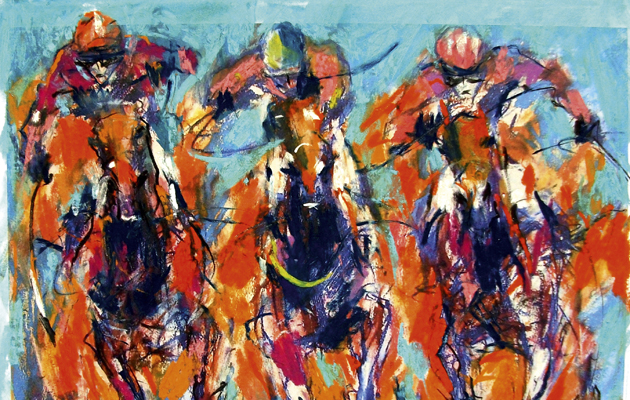Alasdair Banks’s ability to capture movement as well as the atmosphere of an event gives his work a primeval quality, finds Janet Menzies.
There is a case to be made that the earliest art of all is sporting art. The paintings of horses, bison, lions and hyenas in the Chauvet Cave in France’s Ardèche region give a vivid impression of the movement and wild beauty of the creatures these early humans shared their lives with. Thirty-thousand years later, Glasgow-based artist Alasdair Banks is on the same quest – with interestingly similar results.
His paintings of racing especially have an explosion of line that expresses not just the movement of the horses but everything about the race. You can hear the hooves, the horses breathing and the noise of the crowd. Banks says: “My work is very much expressionist. The sense of movement is important to me and
I want to communicate that to people. I want to capture the feeling of what it is like to be at a race meeting.
“I am not from a horse-related background; I worked in the car business for 10 years before I went to art school. For me, the art comes first and the horse comes second but I do find horses fascinating – it is to do with the contrast between the extreme musculature built on these delicate bones and the amazing angles created by the legs in motion.”
Banks’s absorption in his art is controversial at times. “A number of racing traditionalists don’t like my style,” he says. “They may find it disrespectful. I get people pointing out that something isn’t anatomically accurate. And the equestrian art world is fairly conservative, so I am pushing the boat out. That’s why it is good to go to events and paint live, with an audience. I love being heckled! I go to the Cheltenham Festival and you argue with people about what you are doing and why, and you get a lot of positive feedback as well.
I feel that I’m participating in the day’s racing.”
For Banks, art is communication and he has pioneered the concept of Fine Art – Live, where painting meets performance. “I usually do this at a big sporting or charity event. I will start a big painting or graphic at the beginning of the event and finish it in time for it to be auctioned off, usually for charity. I talk about what I am doing and why, and interact with the audience. It can really test you. I did one recently in Edinburgh in front of 500 people and there is no hiding place; you know you have to do good work. I did one about Leonardo da Vinci’s equine drawings, showing slides, discussing his work and doing live drawings, which was really exhilarating.”
The idea for Fine Art – Live had humble beginnings. “I had a van and a trailer-load of pictures and I used to go round the big events, such as Badminton and Hickstead. To catch people’s attention I got into the habit of setting up my easel and doing live drawing. It got you a discount off your stall as well.”
After graduating from Edinburgh College of Art, Banks worked initially in arts management and teaching but his drive to communicate through art wouldn’t be denied. “I just felt I was getting lazy and not pushing myself to get my stuff out there so, with a lot of encouragement from my wife, I went out on my own about 15 years ago.”
Despite his success, Banks still considers himself an outsider. “I feed on criticism and I’m trying to come up with different ideas. I’m not an equestrian artist like Munnings was. He could draw a horse but his work was steeped in his own social milieu and it didn’t move art on one iota. The man was against Picasso.”
Of course, Picasso depicted a horse as a central image in his painting Guernica. But there is a distinction to be made between paintings of horses, dogs and other favourite sporting scenes and art the subject of which happens to be equestrian or sporting. Banks is firmly in the latter category.
Work by Alasdair Banks will be exhibited by Equestrian Art at events throughout the Season; for information on Fine Art – Live, visit www.alasdairbanks.com.





